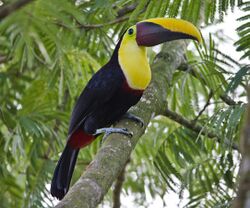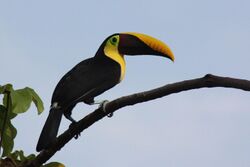Biology:Chestnut-mandibled toucan
| Chestnut-mandibled toucan | |
|---|---|

| |
| In Costa Rica. | |
| Scientific classification | |
| Domain: | Eukaryota |
| Kingdom: | Animalia |
| Phylum: | Chordata |
| Class: | Aves |
| Order: | Piciformes |
| Family: | Ramphastidae |
| Genus: | Ramphastos |
| Species: | |
| Subspecies: | R. a. swainsonii
|
| Trinomial name | |
| Ramphastos ambiguus swainsonii Gould, 1833
| |
| Synonyms | |
| |
The chestnut-mandibled toucan or Swainson's toucan (Ramphastos ambiguus swainsonii) is a subspecies of the yellow-throated toucan which breeds from eastern Honduras to northern Colombia to western Ecuador.
Taxonomy and systematics
The scientific and alternative English names commemorate the English ornithologist and artist William Swainson. From 2009, it has been considered a subspecies of the yellow-throated toucan.[1]
Description
Like other toucans, the chestnut-mandibled is brightly marked and has a large bill. The male is 56 cm long, while the smaller female is typically 52 cm long. Weight ranges from 599 to 746 grams (1.3–1.6 lbs).[2]
The sexes are alike in appearance, mainly black with maroon hints to the head, upper back and lower breast. The face and upper breast are bright yellow, with narrow white and broader red lines forming a lower border. The upper tail is white and the lower abdomen is red. The legs are blue. The body plumage is similar to that of the smaller keel-billed toucan, but the bill pattern is quite different, being diagonally divided into bright yellow and maroon.
Juvenile birds are sooty-black, and have duller plumage, particularly with respect to the bib, red border, and lower mandible. They are fed by the parents for several weeks after leaving the nest.
The call of the chestnut-mandibled toucan is a yelping yo-YIP, a-yip, a-yip, or a Dios te dé, Dios te dé, Spanish for "God give you..."). It is given to maintain contact as the flock travels in "follow-my-leader" style through the trees, but also in chorus at the evening roosts.
Behavior
Small flocks, usually consisting of 3–12 birds, move through the forest with an undulating flight, rarely travelling more than 100 m at a time. This species is primarily an arboreal fruit-eater, but will also take insects, lizards, eggs, and frogs. Flocks will follow keel-billed toucans to exploit their sources of food.
Reproduction
The chestnut-mandibled toucan is a resident breeder in moist lowland forest. The 2–4 white eggs are laid in an unlined cavity high in a decayed section of a living tree, or occasionally in an old woodpecker nest in a dead tree.
Both sexes incubate the eggs for at 14–15 days, and the toucan chicks remain in the nest after hatching. They are blind and naked at birth, and have short bills and specialised pads on their heels to protect them from the rough floor of the nest. They are fed by both parents, and fledge after about 6 weeks.
Aviculture
Chestnut-mandibled toucans are sometimes kept as pets. They are the most readily available 'large toucan' species available in aviculture in the USA; but are considered noisy when compared to other species of toucans.[3] It is illegal to take toucans or any other protected wild bird species from their nests.[4]
References
- ↑ "Species Version 2 « IOC World Bird List". http://www.worldbirdnames.org/updates/archives/species-2-0-2-11/.
- ↑ "Ramphastidae (Toucans, Toucanets, & Aracaris)". Archived from the original on 19 August 2007. https://web.archive.org/web/20070819114100/http://www.nashvillezoo.org/piciformes/ramphastidae.htm. Retrieved 2007-08-19.
- ↑ Summers, Amado. "Toucans!". Organization of Professional Aviculturists, Inc.. http://www.proaviculture.com/toucans.htm. Retrieved 19 May 2010.
- ↑ Hofverberg, Elin (2021-09-20). "Can you Legally Import a Toucan? No, you Probably Cannot | In Custodia Legis: Law Librarians of Congress". https://blogs.loc.gov/law/2021/09/can-you-legally-import-a-toucan-no-you-probably-cannot/.
- F. Gary Stiles & Alexander F. Skutch (1989). A Guide to the Birds of Costa Rica. ISBN:0-8014-9600-4.
- Steven L. Hilty (2003). Birds of Venezuela. ISBN:0-7136-6418-5.
External links
- Information on and sounds of the chestnut-mandibled or Swainson's toucan, Ramphastos swainsonii.
Wikidata ☰ Q1073624 entry
 |




